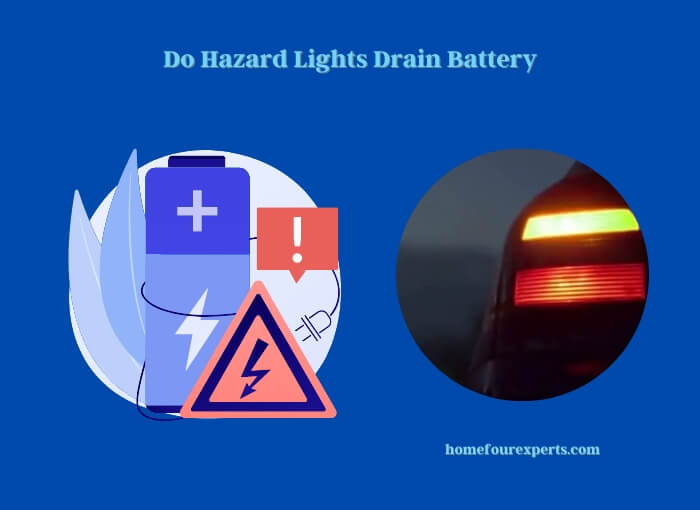Published on: May 15, 2022
Written by Liam Jaxon / Fact-checked by David Rowan
Once your automobile broke down, you pulled over the car to a safe area and turned on your hazard lights to seek help from other drivers. During this period, you turned on the hazardous light for around 60 to 90 minutes. Then when you attempted to start the car, the battery was dead! Then you may have the following question: “Do hazard lights drain the battery?” This circumstance we experienced once in a life.

Hazard lights are a pair of synchronized, intermittently flashing indicator lights. It’s important to activate hazard lights when you’ve stopped on the roadside due to a technical issue. They let other drivers know that you’re temporarily blocking their path. Any electrical gadget in your vehicle, including headlights, radios, and even door pins, can become a drain if left on. These items can cause problems with the battery if they are left to run while your vehicle’s engine is turned off.
After using a multimeter to determine the amperage of seven different cars, we determined whether or not “can hazard lights kill your battery?“. We will share our findings with you in this article.
What Do Hazard Lights Look Like?
Hazard lights are often started by pressing a red triangle-shaped button on the dashboard. Specific vehicles have automatically activated hazard warning lights when the car is subjected to severe braking or is engaged in an accident.
Use of Hazard Lights
There are various reasons to stop the car in an emergency situation, such as breaking down, being in an accident, running out of petrol, or being controlled by a roadblock. If your vehicle is stopped, use your hazard lights to alert other drivers.
While driving, you should only use your hazard lights if you are on a highway and there is a blockage ahead that traffic behind must be alerted of. This implies you should not use your warning lights while towed unless you are on a motorway or unrestricted dual carriageway and must warn other vehicles of impending danger. However, the hazard lights should be on for a while for other cars to notice the warning.
You might have a question in mind,’ When should you not use hazard lights?‘ Well, never use hazard lights to rationalize unsafe or illegal parking. Additionally, you should not use them to express gratitude to other road users who allow you to pass through a junction.
How Long Can You Have Your Hazards on?
You can use hazard lights for 4 to 5 hours, depending on your battery age and size. If you want to be safe or your battery is already a few years old, stick to 3 hours. If you have both hazard lights and headlights on then, you only have 60 to 90 minutes.
One hundred watts is equal to four hazard lamps. That equals 8 amps or roughly when powered by your 12-volt battery. If you have a new 80 amp battery, you should be able to run the hazards for approximately 10 hours.
It’s simple math to calculate how long does it take for hazard lights to drain the battery? But it’s a bit complex because all car batteries are different. Also, the vehicle’s fitness level and total amp-hours will draw a different amperage while the hazard lights and headlights are on.
Also, the number of lights and the type of bulbs determines the battery’s amperage. Car batteries are rarely rated in amp-hours; thus, we use Reserve capacity or cold-cranking amps to gauge them. These ratings are useless when determining how long a battery can power something when the amperage is known.
The chart below shows the different battery sizes and how long it takes to reach 50% charge when only the hazard lights are on and when with the headlights.
| Car Battery | Only Hazard Lights Until 50% Battery | Hazard & Low Beam Headlights, 50% Battery |
| Small CarAH 36-46.2 | 4 Hours | 75 Minutes |
| Medium CarAH: 46.2-58.8 | 5 Hours | 90 Minutes |
| Large CarAH: 58.8-111 | 7 Hours | 135 minutes |
Do Hazard Lights Drain the Car Battery?
Leaving your hazard lights on for long periods while the engine is not operating will begin to degrade the performance of your car’s battery. This is caused by the battery plates becoming sulphated, which reduces their ability to accept a charge and discharge electricity.
The issue with deep discharging your automobile battery is that they are designed to be starting batteries and will have a significantly reduced lifespan if released to 50% or below. For instance, if you leave your warning lights on for an hour or less and then start your motor and drive for about 30 minutes, you are not harming them. But, if you leave your hazard lights on for 4 hours or longer, it requires a jump to start your car because you’ve just deep drained your car battery.
Marine and golf cart batteries are built to withstand deep discharges and be recharged hundreds of times. On the other hand, an automobile battery has around a dozen total deep discharges. You’ll get a few dozen if you only go to 50%. Sulfation occurs exponentially when a car battery’s state of charge falls below 75%. An insulator prevents the lead plates from taking charge and releasing the tremendous burst of electricity required to start your car.
Suppose you’ve kept your hazard lights on for an extended period. When you get home, we recommend driving your vehicle for 30-60 minutes or charging it with a specialized battery charger to break up any sulfate crystals or blood plates that have formed before they harden and become difficult to remove.
How to Start a Car With Drain Battery
Get your jumpers. If your car battery dies after too much time with hazard lights on, you can either acquire a jump from another vehicle or provide your own. There are many great little jump starter devices you can keep in your car to face the situation.
First, park or keep the car neutral, with the ignitions off and the emergency brakes engaging. Then remove both battery tops, and a spark might set off a battery’s explosive hydrogen gas. Open the caps to avert an explosion. It has safety valves. Connect the clips to the designated locations and attempt to start your vehicle. Avoid turning off your engine; instead, drive around for a few minutes to replenish your battery.
FAQs
How Do I Switch Off Hazard Lights?
When there is an emergency, push the hazard button to have all turn signal lights flash simultaneously. To turn them off, press the button one more time.
Can a Bad Starter Solenoid Cause the Hazard Lights to Drain the Battery?
When dealing with a faulty starter solenoid, it’s possible for it to cause a drain on the battery. However, the hazard lights themselves are not typically linked to this issue. The starter solenoid battery drain can result in a dead battery over time if left unattended, so it’s important to address this problem promptly to prevent further inconvenience.
How Long Can Hazard Lights Be Left on Without Draining the Battery?
It is generally recommended that hazard lights be used in short intervals of 5 to 10 minutes. If hazard lights are left on for extended periods of time, it can cause the battery to drain.
Why Are My Hazard Lights on?
After switching off the hazard lights, if the flasher has an internal short, the hazard light may stay on instead of flashing. While the lights may still be visible, they will not signal a turn or an emergency.
Will Hazard Lights Drain the Battery?
[amazon link=”B085T1RK2K” title=”Hazard lights” /] might drain your car’s battery. Any electrical gadget in your vehicle can become a drain if they are left running while your vehicle’s engine is turned off.
Is It Safe to Use Hazard Lights in Bad Weather?
It is generally not safe to use hazard lights in bad weather. Hazard lights may cause other drivers to think that your vehicle is stopped, which can lead to a collision. Instead, use your regular headlights and keep your speed low when driving in bad weather.
Final Verdict
We hope you already get your answer to “do hazard lights drain battery” or not. Turning on the Hazard light for a longer time is most likely the most well-known cause of complete battery drain. The hazard lights are meant to consume minimal power to buffer the draw on your battery; hence, your hazard lights can and will ultimately totally deplete your battery.
Fortunately, you can have an instant remedy by jump-starting your car, and in most cases, your battery will be fine afterward. However, if you repeatedly drain your battery in this manner, you risk severely shortening its lifespan or causing it to fail entirely.
Featured image credit: philkotse.com
Read more:
- Lithium CR1616 Battery Equivalents and Replacements Charts
- Does Battery Voltage Drop When It Discharges
About This Writer

Hi, I am responsible for the 'Homeowners Power Solutions' category. My name is Liam Jaxon and a licensed technician with 7 years of experience in vehicle batteries, electrical gadgets, and home appliances. My working experience in different residential & light commercial electrical sectors and the automobile industry helped to acquire vast knowledge in this industry.